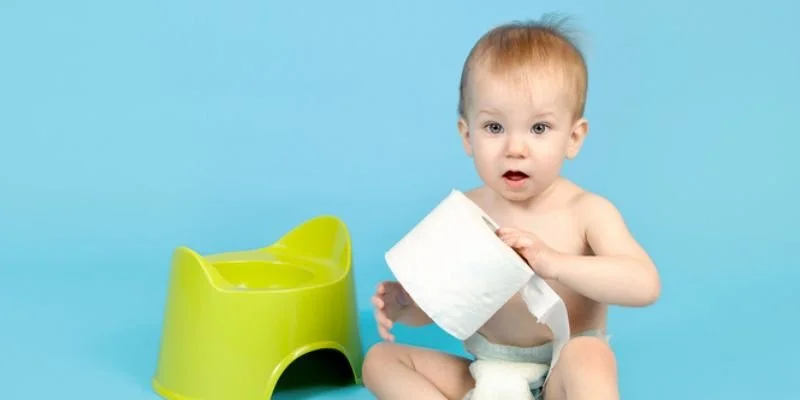Potty Training a Boy
Are you ready to start potty training your child? Congratulations! This is an important milestone for both of you. Although potty training boys can be a stressful experience, don't let it put you off. Consistency is key here!
As well as teaching your little boy to use the potty sitting down, how to use it standing up too comes later and in their own time, which is why we've created this article to give you a step-by-step guide to potty training success.
When can you start potty training?
The first step is to identify if your little man is ready to swap nappies for potty training fun! If he isn't ready, your potty training journey may take longer
The recommended age that children are ready to potty train is between 18 months and 3 years old. The average age that most children start is around 2.5 years old.
If your little man is showing some of the following signs, it's likely that he's ready to start potty training:
He has dry nappies for two hours or more at a time – not all children will experience this but it’s something to keep an eye out.
He can feel the sensation to go and tells you
He knows when he has a wet or dirty nappy and may pull at it or tell you
He may hide to go to the toilet in his nappy
He can follow simple instructions
He seems interested in the toilet
It's true that boys tend to potty train later than girls, and this is because they typically develop readiness skills much later. Girls tend to develop these skills just before they turn 2, whereas boys develop them when shortly after turning 2.
Of course, every child is different and with potty training, there is no one size fits all which is why it's important you look out for signs of readiness.
How long will it take to completely toilet train my boy?
This will vary for every child. How long it takes completely depends on his readiness and personality.
As a rule of thumb, it can take one week to several months for a child to be completely potty trained. Some children might grasp it quicker than others and this is normal. It's likely your child will master the art of potty training during the day before they master staying dry at night and it's important that you tackle day and nighttime training separately. A very small minority will train simultaneously.
It often takes between 3 and 6 months but can take more or less time for some children. If you start too soon, the process tends to take longer.
How to start potty training boys
Parenting can be a minefield. Knowing how to begin doing something can be incredibly daunting, but with our step-by-step guide, we give you all the potty training tips you need to ensure that you can ditch the nappies for good!
Buy toilet training supplies
First things first, you need to invest in some supplies to get started. Our list includes:
Potty or a potty seat that sits on top of your toilet
Easy-to-wear clothing
It's also an idea to invest in a chart for your wall and some little prizes or stickers so that you can reward your little boy when he goes to the toilet successfully.
Let him watch and learn
Kids can learn by observing, so letting your boy see the adults or their siblings use the bathroom is the first step to them starting their very own potty training journey. He may notice that the boys and girls use the toilet differently, that could be when they sit verses stand! If he does, you can use this as a great opportunity to explain how boys go to the toilet.
Set a date to begin
Set a date to begin
If your little one is showing the signs that he's ready for potty training and you are armed with all the equipment you need to make it as smooth a ride as possible, then set a date when you will dedicate time to potty train.
In the lead-up to starting, you could read some books about potty training with your child, or watch a TV show where potty training is the focus. This will ensure that your little one knows what to expect.
It's best to start potty training when you will be at home and can dedicate the time to it. If you are planning to go on holiday, it's recommended that you avoid potty training until you are back.
Other tips for starting:
Have your son use the potty as soon as he wakes after he has eaten and just before bedtime. Scheduling the time to use the potty will help him to use it.
Ask your child to tell you when he has the urge to go so that you can take him before any accidents.
Don't let your little one sit on the potty for an extended period. If it's not happening, take a break and try again later
Potty train on the go
Once your child has started to use the potty confidently, try testing it when you're out and about. This is a huge milestone that you can be both be proud of.
Ensure your child is wearing loose-fitting clothes and don’t forget to bring some spare clothes with you just in case. Before you leave the house, encourage your son to use the toilet and do the same when you arrive and leave your destination.
Try big boy underwear
One top tip is to let your son pick out his underwear as this helps him feel empowered and independent.
Encourage your child to put his pants on, on day one of training.
Standing up
When you start potty training, have your son sit on the potty to pee as this will be easier. However, as the days and months go by, you may want to consider teaching him how to stand and pee.
There's no pressure to do this straight away, but a few tips to help your little one pee standing are:
Have him stand closer to the toilet as this makes peeing standing up easier (and less messy!)
Make a game out of it and consider using a target for practice, for example, cheerio cereal
Practice - the only way he will understand what to do is by practising, so give him the opportunity to do it and learn.
Work on nighttime training last
Many children will be taught how to potty train in two stages - daytime and nighttime. Daytime training is easier as your child is awake and alert so can let you know when they need to go.
Nighttime is a little more of a challenge as it involves your child knowing that they need to go in the night and you need to understand whether your little one is ready for it.
To successfully potty train at night, your child may be demonstrating the following signs:
Dry nappy each morning
They already go to the potty at night
They ask to use the potty at night
They don't want to wear a nappy to bed
They go to the toilet on waking as they have been holding in their pee all night
Potty training tips
Potty training can be a mixture of emotions. You'll be jumping for joy one minute and frustrated the next, if accidents are continual (although part of the learning).
The main thing to remember is your child will develop at their own rate, try not to compare them to other siblings or children. If you start potty training too early, you will face challenges so it's best to do it when your boy is showing he is ready.
Some top potty training tips for boys are:
Accidents - if your child is having accidents, keep calm. Clean it up and move on. Continue to highlight the importance of peeing and pooing in the potty and praise him when he does.
Out and about - for the first few outings, you should consider going somewhere familiar such as a family member's house. Ensure you have a bag of spare clothes just in case and remember to not get frustrated if he does have an accident.
Childcare - be sure to discuss your plans with your childcare provider about toilet training, this way you can ensure consistency.
If you have tried potty training your child but it's not working out it can be easy to feel frustrated. Try not to put too much pressure on you and your child. If it's not sinking in, maybe your little one isn't ready yet.
If he's not ready, our advice is to stop and try again in a few weeks or months when he is showing signs of readiness.



